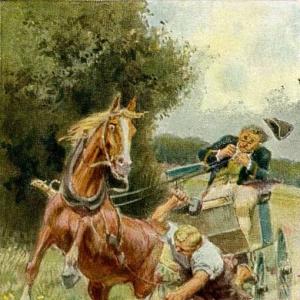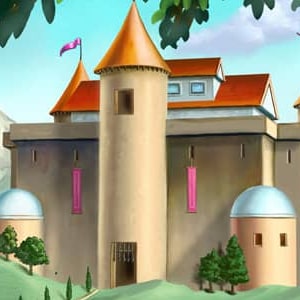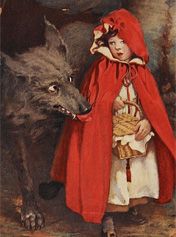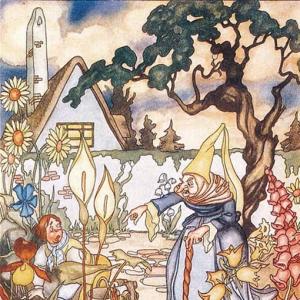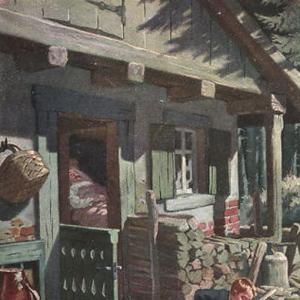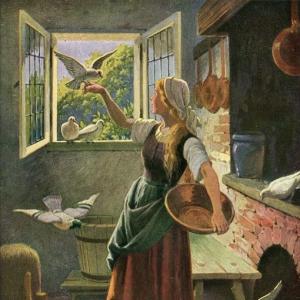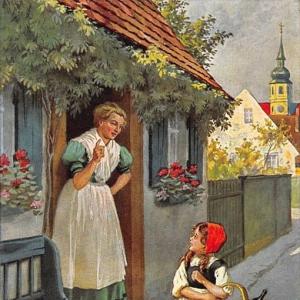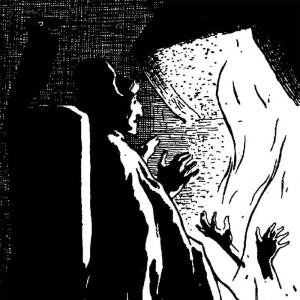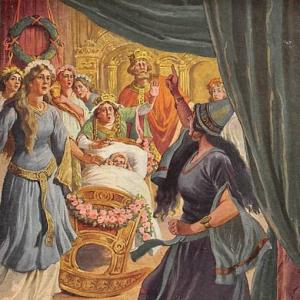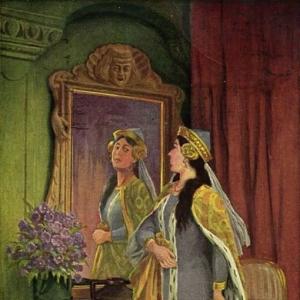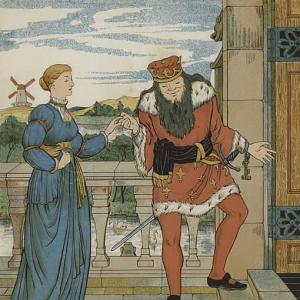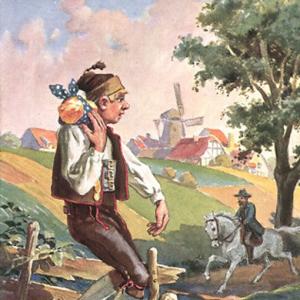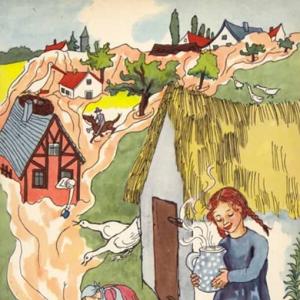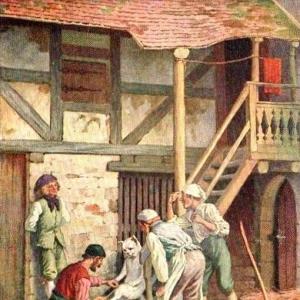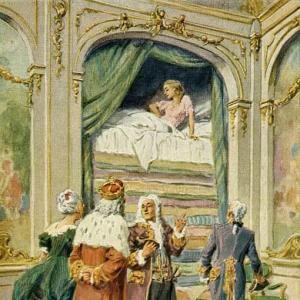Reading time for children: 10 min
There was once an ass whose master had made him carry sacks to the mill for many a long year, but whose strength began at last to fail, so that each day as it came found him less capable of work. Then his master began to think of turning him out, but the ass, guessing that something was in the wind that boded him no good, ran away, taking the road to Bremen. For there he thought he might get an engagement as town musician. When he had gone a little way he found a hound lying by the side of the road panting, as if he had run a long way.
„Now, Holdfast, what are you so out of breath about?“ said the ass. „Oh dear!“ said the dog, „now I am old, I get weaker every day, and can do no good in the hunt, so, as my master was going to have me killed, I have made my escape; but now, how am I to gain a living?“ – „I will tell you what,“ said the ass, „I am going to Bremen to become town musician. You may as well go with me, and take up music too.
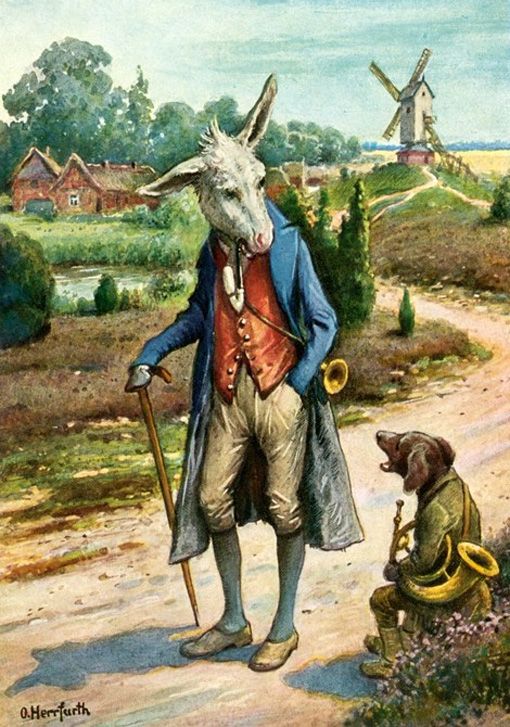 Image: Oskar Herrfurth (1862-1934)
Image: Oskar Herrfurth (1862-1934)I can play the lute, and you can beat the drum.“ And the dog consented, and they walked on together. It was not long before they came to a cat sitting in the road, looking as dismal as three wet days. „Now then, what is the matter with you, old shaver?“ said the ass. „I should like to know who would be cheerful when his neck is in danger,“ answered the cat.
„Now that I am old my teeth are getting blunt, and I would rather sit by the oven and purr than run about after mice, and my mistress wanted to drown me. So I took myself off; but good advice is scarce, and I do not know what is to become of me.“ – „Go with us to Bremen,“ said the ass, „and become town musician. You understand serenading.“ The cat thought well of the idea, and went with them accordingly.
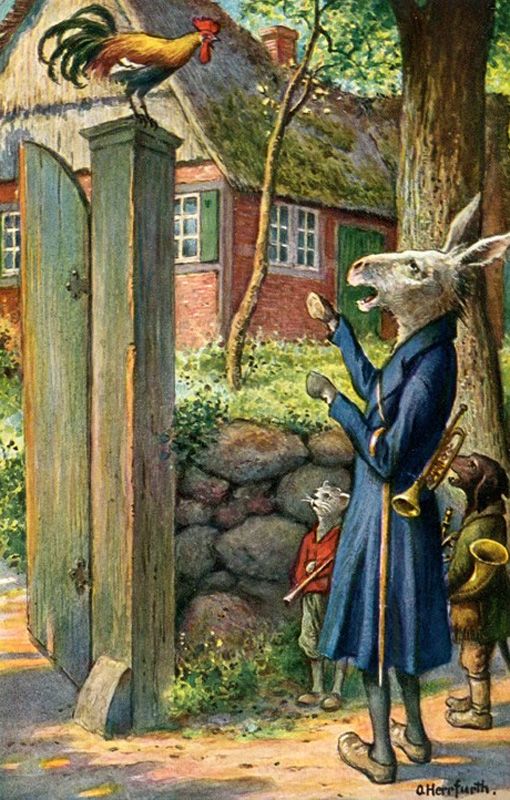 Image: Oskar Herrfurth (1862-1934)
Image: Oskar Herrfurth (1862-1934)After that the three travellers passed by a yard, and a cock was perched on the gate crowing with all his might. „Your cries are enough to pierce bone and marrow,“ said the ass; „what is the matter?“ – „I have foretold good weather for Lady-day, so that all the shirts may be washed and dried; and now on Sunday morning company is coming, and the mistress has told the cook that I must be made into soup, and this evening my neck is to be wrung, so that I am crowing with all my might while I can.“
„You had much better go with us, Chanticleer,“ said the ass. „We are going to Bremen. At any rate that will be better than dying. You have a powerful voice, and when we are all performing together it will have a very good effect.“ So the cock consented, and they went on all four together. But Bremen was too far off to be reached in one day, and towards evening they came to a wood, where they determined to pass the night. The ass and the dog lay down under a large tree. The cat got up among the branches, and the cock flew up to the top, as that was the safest place for him.
Before he went to sleep he looked all round him to the four points of the compass, and perceived in the distance a little light shining, and he called out to his companions that there must be a house not far off, as he could see a light, so the ass said, „We had better get up and go there, for these are uncomfortable quarters.“ The dog began to fancy a few bones, not quite bare, would do him good. And they all set off in the direction of the light, and it grew larger and brighter, until at last it led them to a robber’s house, all lighted up.
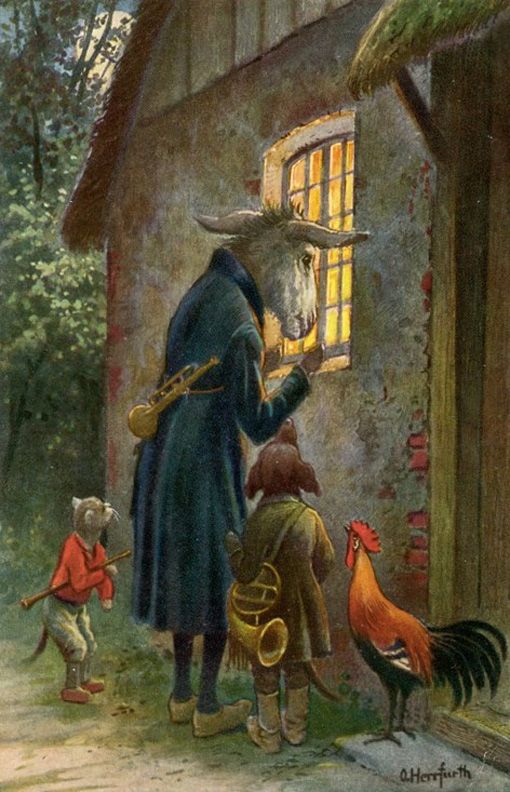 Image: Oskar Herrfurth (1862-1934)
Image: Oskar Herrfurth (1862-1934)The ass being the biggest, went up to the window, and looked in. „Well, what do you see?“ asked the dog. „What do I see?“ answered the ass; „here is a table set out with splendid eatables and drinkables, and robbers sitting at it and making themselves very comfortable.“ – „That would just suit us,“ said the cock. „Yes, indeed, I wish we were there,“ said the ass. Then they consulted together how it should be managed so as to get the robbers out of the house, and at last they hit on a plan.
The ass was to place his forefeet on the window-sill, the dog was to get on the ass’s back, the cat on the top of the dog, and lastly the cock was to fly up and perch on the cat’s head. When that was done, at a given signal they all began to perform their music. The ass brayed, the dog barked, the cat mewed, and the cock crowed. Then they burst through into the room, breaking all the panes of glass.
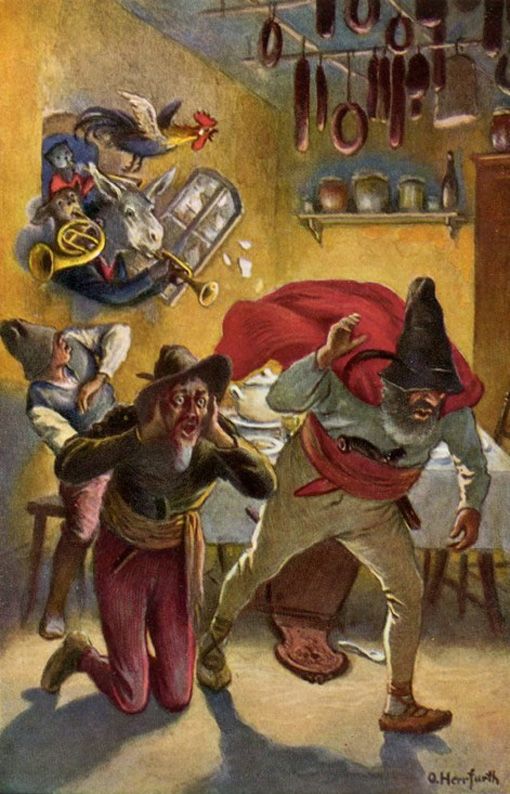 Image: Oskar Herrfurth (1862-1934)
Image: Oskar Herrfurth (1862-1934)The robbers fled at the dreadful sound. They thought it was some goblin, and fled to the wood in the utmost terror. Then the four companions sat down to table, made free with the remains of the meal, and feasted as if they had been hungry for a month. And when they had finished they put out the lights, and each sought out a sleeping-place to suit his nature and habits. The ass laid himself down outside on the dunghill, the dog behind the door, the cat on the hearth by the warm ashes, and the cock settled himself in the cockloft, and as they were all tired with their long journey they soon fell fast asleep.
When midnight drew near, and the robbers from afar saw that no light was burning, and that everything appeared quiet, their captain said to them that he thought that they had run away without reason, telling one of them to go and reconnoitre. So one of them went, and found everything quite quiet. He went into the kitchen to strike a light, and taking the glowing fiery eyes of the cat for burning coals, he held a match to them in order to kindle it. But the cat, not seeing the joke, flew into his face, spitting and scratching.
Then he cried out in terror, and ran to get out at the back door, but the dog, who was lying there, ran at him and bit his leg; and as he was rushing through the yard by the dunghill the ass struck out and gave him a great kick with his hind foot; and the cock, who had been wakened with the noise, and felt quite brisk, cried out, „Cock-a-doodle-doo!“
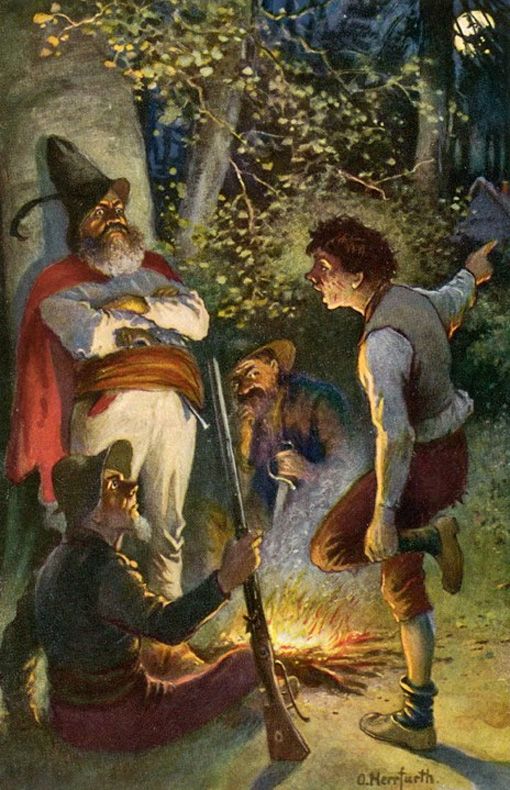 Image: Oskar Herrfurth (1862-1934)
Image: Oskar Herrfurth (1862-1934)Then the robber got back as well as he could to his captain, and said, „Oh dear! In that house there is a gruesome witch, and I felt her breath and her long nails in my face; and by the door there stands a man who stabbed me in the leg with a knife; and in the yard there lies a black spectre, who beat me with his wooden club; and above, upon the roof, there sits the justice, who cried, „Bring that rogue here!“ And so I ran away from the place as fast as I could.“
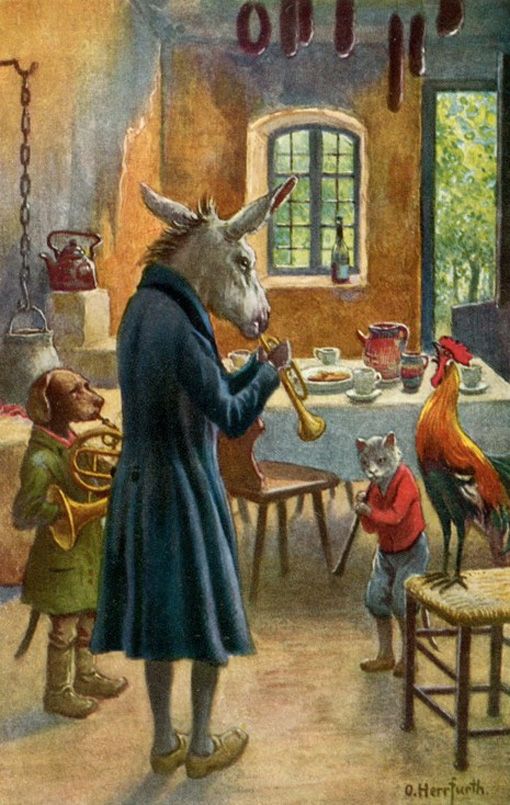 Image: Oskar Herrfurth (1862-1934)
Image: Oskar Herrfurth (1862-1934)From that time forward the robbers never ventured to that house, and the four Bremen town musicians found themselves so well off where they were, that there they stayed. And the person who last related this tale is still living, as you see.
 Learn languages. Double-Tap on one word.Learn languages in context with Childstories.org and Deepl.com.
Learn languages. Double-Tap on one word.Learn languages in context with Childstories.org and Deepl.com.Backgrounds to fairy tale „The Bremen Town Musicians“
„The Bremen Town Musicians“ is a popular fairy tale collected by the Brothers Grimm in their collection „Grimm’s Fairy Tales“ (originally titled „Children’s and Household Tales“ or „Kinder- und Hausmärchen“ in German), which was first published in 1812. The tale is known as ATU 130 in the Aarne-Thompson-Uther classification system, which is used to categorize folktales based on their narrative structure and elements. The Brothers Grimm, Jacob and Wilhelm, were German academics, linguists, and cultural researchers who collected and published numerous folk and fairy tales during the 19th century. Their goal was to preserve the cultural heritage and oral storytelling traditions of German-speaking regions.
The tales they collected were often based on stories passed down through generations and have roots in older myths and legends. The fairy tale, like many others in the Grimm’s collection, has been adapted into numerous formats, including books, plays, films, and television shows. The tale is a popular children’s story and has been translated into various languages. The story is often used as a teaching tool to encourage themes such as teamwork, creativity, and resilience. The tale has also been the inspiration for various monuments and sculptures, most notably the famous bronze statue in Bremen, Germany, which was created by Gerhard Marcks in 1953.
„The Bremen Town Musicians“ tells the story of four aging domestic animals – a donkey, a dog, a cat, and a rooster – who are no longer useful to their masters and are facing mistreatment or abandonment. The animals decide to leave their homes and travel to Bremen, a city in northern Germany, with the goal of becoming musicians. Along the way, they come across a cottage inhabited by a group of robbers. The animals work together to scare the robbers away by using their unique talents and loud noises. In the end, they decide to stay in the cottage instead of continuing their journey to Bremen, finding a new home and a sense of belonging.
The story emphasizes the themes of cooperation, friendship, and the idea that everyone has value and can contribute to society, no matter their age or abilities. It also serves as a reminder that teamwork can overcome adversity, and that there is strength in unity. The specific origins of „The Bremen Town Musicians“ are not well documented, but it is likely that the story has roots in older folktales and legends that celebrate the value of collaboration and the power of unlikely friendships. The tale may have evolved from oral storytelling traditions that were influenced by the experiences of people in German-speaking regions, reflecting their values and cultural beliefs.
Interpretations to fairy tale „The Bremen Town Musicians“
„The Bremen Town Musicians“ offers several themes and interpretations that resonate with readers, showcasing the richness and depth of Grimm fairy tales. Some key interpretations of this story include:
Collaboration and teamwork: One of the main themes of „The Bremen Town Musicians“ is the power of cooperation and teamwork. The four animals, despite their differences and individual weaknesses, join forces and use their unique skills to overcome obstacles and achieve their goals. This theme serves as a reminder that people can often accomplish more by working together than by struggling alone.
Overcoming adversity: Each of the animals in the story faces hardship, rejection, or mistreatment, yet they refuse to give up. Instead, they choose to forge a new path together, ultimately finding a sense of belonging and a new purpose in life. The story encourages resilience and determination in the face of adversity. The animals in the story are all older and facing various challenges due to their age. The tale demonstrates that, despite these difficulties, they can still find purpose, happiness, and a sense of belonging. This message serves as a reminder that it is never too late to reinvent oneself and find new opportunities in life.
Strength in unity: The animals, although individually weak, become a formidable force when they work together. Their collective effort enables them to outsmart the robbers and secure a better life. This theme highlights the importance of teamwork and the idea that individuals can achieve greater success when they join forces with others.
The power of music and art: The animals come together through their shared desire to become musicians. In the end, it is their music that scares away the robbers and grants them a new life. This aspect of the story emphasizes the power of art and creativity as a means of transformation and salvation.
Rejection of societal norms: Each animal is initially cast aside by their masters due to their diminishing usefulness or impending doom. However, they defy societal expectations and forge their own path, ultimately finding happiness and success. This interpretation suggests that one should not be limited by societal norms and should have the courage to create their own destiny.
Resourcefulness and adaptability: Faced with various challenges, the animals consistently find ways to overcome their obstacles. Their ability to adapt and think creatively allows them to achieve their goals. This theme underlines the importance of being resourceful and adaptable in the face of challenges in life.
The value of every individual: The tale highlights the idea that everyone, regardless of age or abilities, has something valuable to contribute to society. The animals, initially considered useless by their masters, prove their worth by using their unique talents to confront the robbers. This theme promotes the importance of recognizing and appreciating the contributions of others.
Friendship and loyalty: The four animals form a strong bond of friendship throughout their journey, demonstrating the importance of loyalty and support in overcoming life’s challenges. The story suggests that true friendship can transcend differences and provide a sense of belonging.
Age and wisdom: The animals in the story are older and wiser, having experienced many aspects of life. The tale implies that age can bring valuable insights and capabilities, rather than being a limitation. It encourages respect for the wisdom and experience that comes with age.
The story features a group of older animals, specifically a donkey, a dog, a cat, and a rooster, who decide to leave their homes and seek new lives as musicians in the town of Bremen. Along the way, they encounter a house full of robbers and use their newfound unity and talents to scare them away. In the end, the animals find happiness and security together in the house. Overall, „The Bremen Town Musicians“ provides a rich narrative with multiple layers of interpretation. The story focuses on themes of collaboration, overcoming adversity, the value of every individual, friendship, and the respect for age and wisdom. These themes contribute to the enduring appeal and relevance of the tale in various cultural contexts.
Adaptions of the fairy tale „The Bremen Town Musicians“
„The Bremen Town Musicians“ is a German folktale collected by the Brothers Grimm, Jacob and Wilhelm Grimm, in their famous anthology „Grimm’s Fairy Tales“ („Kinder- und Hausmärchen“) first published in 1812. The Brothers Grimm were prominent German scholars and cultural researchers who dedicated their lives to preserving and studying the folktales and oral traditions of the German-speaking world. „The Bremen Town Musicians“ has been adapted into various forms of media over the years, demonstrating its enduring appeal and the versatility of the Brothers Grimm’s fairy tales. Some specific examples of these adaptations include:
Literature: „The Musicians of Bremen“ by Brian Wildsmith: This beautifully illustrated children’s book retells the classic story with vibrant artwork, making it accessible and appealing to younger readers. The story has been adapted into numerous picture books for children, including versions illustrated by famous artists such as Gerda Muller and Kinuko Craft. The story has also been adapted into variations in other cultures, including the Russian tale „The Fool and the Birch Tree“ and the Hungarian tale „The Four Minstrels.“
Films: „Los Trotamúsicos“ (1989): This Spanish animated film is an adaptation of „The Bremen Town Musicians,“ following the adventures of four animals as they form a musical group and face various challenges together.
Television: „SimsalaGrimm“ (1999-2010): The German animated series, which retells various Grimm fairy tales, features an episode titled „Die Bremer Stadtmusikanten,“ adapting the story of „The Bremen Town Musicians“ for a modern audience. „The Bremen Town Musicians“ has also been adapted in modern media, such as in the television series „Grimm,“ where the characters Nick and Monroe refer to themselves as the „Bremen Town Musicians“ in one episode.
Theater and musicals: „Die Bremer Stadtmusikanten“ (1959): This East German musical film adapts the fairy tale into a lively and entertaining production, showcasing the adventures of the four animal friends. „The Bremen Town Musicians“ by Ric Averill: This stage adaptation of the fairy tale is a family-friendly musical that incorporates humor and lively songs to retell the classic story. The story has been adapted for the stage in various forms, including as a puppet show, a musical, and a play. The tale’s lively characters and catchy songs make it a popular choice for children’s theater productions.
Animation: „Town Musicians of Bremen“ (1969): This Soviet animated film, directed by Inessa Kovalevskaya, retells the story of „The Bremen Town Musicians“ with a unique visual style, staying true to the spirit of the original tale. There have been many animated adaptations of the story, including the 1922 silent film „The Bremen Town Musicians,“ the 1959 Soviet film „The Bremen Town Musicians,“ and the 1989 Japanese anime film „The Bremen Avenue Experience.“
Radio: „The Bremen Town Musicians“ BBC Radio 4 adaptation: This radio version of the fairy tale brings the story to life through immersive soundscapes and narration, making it accessible to a broad audience.
These adaptations showcase the enduring appeal of „The Bremen Town Musicians“ and its themes of collaboration, resilience, and friendship. The story has been reimagined in various formats and genres, demonstrating the universality and adaptability of the Brothers Grimm’s classic fairy tales. Overall, „The Bremen Town Musicians“ has proven to be a popular and enduring story that has inspired many adaptations across different media and cultures.
Summary of the plot
„The Bremen Town Musicians“ is a Grimm fairy tale that tells the story of four aging domestic animals who decide to leave their homes to seek new lives as musicians in the city of Bremen. The animals are a donkey, a dog, a cat, and a rooster, each facing abandonment or mistreatment by their masters due to their declining abilities.
The four animals meet on their journey and decide to join forces, hoping that their combined talents will help them succeed in their new careers as musicians. As they travel together, they come across a cottage inhabited by a group of robbers. The animals devise a plan to scare the robbers away by standing on each other’s backs and creating a loud cacophony of sounds, making the robbers believe they are facing a monstrous creature.
After successfully driving the robbers out of the cottage, the animals decide to settle there instead of continuing to Bremen. They find that they have discovered a new sense of belonging and purpose together, even without reaching their original destination. The tale highlights themes of cooperation, friendship, resilience, and the value of every individual, regardless of their age or abilities. The story serves as a reminder that teamwork and loyalty can help overcome adversity and create a better future.
Abstract
„The Bremen Town Musicians“ is a fairy tale by the Brothers Grimm about an aging donkey, dog, cat, and rooster, who band together in search of a better life as musicians in the town of Bremen. The donkey, no longer able to work due to his diminishing strength, leaves his master and encounters a panting dog, who has escaped from his master for similar reasons. The two decide to travel to Bremen together, with the donkey playing the lute and the dog playing the drum.
On their journey, they meet a cat with dulled teeth, who has fled from her mistress fearing drowning. The trio convinces the cat to join them and learn the art of serenading. Lastly, they come across a crowing rooster, who is afraid of being killed for soup. They invite the rooster to join their group as well, as he has a powerful voice.
As Bremen is too far to reach in one day, they decide to spend the night in a forest. The rooster sees a light in the distance and the group heads toward it, discovering a brightly lit house occupied by robbers. The animals devise a plan to scare the robbers away by performing their music loudly and breaking into the house, causing the robbers to flee in terror. The animals enjoy the leftover feast and find their sleeping spots.
Later, the robbers‘ captain sends one of his men to investigate the house. The man encounters the animals, mistaking them for various terrifying creatures, and returns to his captain, recounting the harrowing experience. The robbers never return to the house, and the four Bremen town musicians find happiness and contentment in their new home.
Informations for scientific analysis
Fairy tale statistics | Value |
|---|---|
| Number | KHM 27 |
| Aarne-Thompson-Uther-Index | ATU Typ 130 |
| Translations | DE, EN, EL, DA, ES, FR, PT, FI, HU, IT, JA, NL, KO, PL, RO, RU, TR, VI, ZH |
| Readability Index by Björnsson | 30 |
| Flesch-Reading-Ease Index | 83.2 |
| Flesch–Kincaid Grade-Level | 6.8 |
| Gunning Fog Index | 9.6 |
| Coleman–Liau Index | 6.7 |
| SMOG Index | 8 |
| Automated Readability Index | 7 |
| Character Count | 6.492 |
| Letter Count | 4.925 |
| Sentence Count | 62 |
| Word Count | 1.286 |
| Average Words per Sentence | 20,74 |
| Words with more than 6 letters | 119 |
| Percentage of long words | 9.3% |
| Number of Syllables | 1.560 |
| Average Syllables per Word | 1,21 |
| Words with three Syllables | 42 |
| Percentage Words with three Syllables | 3.3% |

